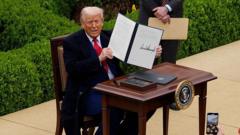The tariff plan, which was initially laid out in April, reflects a persistent trend in U.S. trade policy under Trump. Specifically, he previously suggested tariffs of 24% on Japanese goods and 25% on South Korean imports during an extensive trade policy announcement labeled "Liberation Day." The earlier proposal faced significant backlash and market instability, prompting a temporary halt on the steepest tariffs while negotiations were underway. However, as the deadline approaches for those discussions, Trump appears ready to impose the proposed tariffs.
Reports indicate that the U.S. Treasury Department anticipates a surge of vigorous negotiations in the coming days. Secretary Scott Bessent remarked on the influx of new proposals received in light of the looming tariffs. Trump's rationale for imposing tariffs has been framed as reciprocal, targeting what he terms unfair international trading practices.
Beyond South Korea and Japan, discussions around tariffs extend to major sectors including automobiles and steel with implications for global supply chains and trade relations. Recent agreements with the U.K., Vietnam, and a partial deal with China have also been enacted, though complexities remain unresolved.
Amidst these developments, the European Union is in negotiations to maintain a provisional tax on goods entering the U.S., while simultaneously seeking reductions on Trump’s tariffs imposed on automobiles and metals. In this multifaceted global trade landscape, Trump’s assertive tariff strategy continues to reshape the dialogue and direction of U.S. trade relationships.
With the August 1 deadline fast approaching, the business world and international markets are bracing for the potential impacts of these tariffs, as stakeholders seek clarity amidst the uncertainty.
Reports indicate that the U.S. Treasury Department anticipates a surge of vigorous negotiations in the coming days. Secretary Scott Bessent remarked on the influx of new proposals received in light of the looming tariffs. Trump's rationale for imposing tariffs has been framed as reciprocal, targeting what he terms unfair international trading practices.
Beyond South Korea and Japan, discussions around tariffs extend to major sectors including automobiles and steel with implications for global supply chains and trade relations. Recent agreements with the U.K., Vietnam, and a partial deal with China have also been enacted, though complexities remain unresolved.
Amidst these developments, the European Union is in negotiations to maintain a provisional tax on goods entering the U.S., while simultaneously seeking reductions on Trump’s tariffs imposed on automobiles and metals. In this multifaceted global trade landscape, Trump’s assertive tariff strategy continues to reshape the dialogue and direction of U.S. trade relationships.
With the August 1 deadline fast approaching, the business world and international markets are bracing for the potential impacts of these tariffs, as stakeholders seek clarity amidst the uncertainty.




















